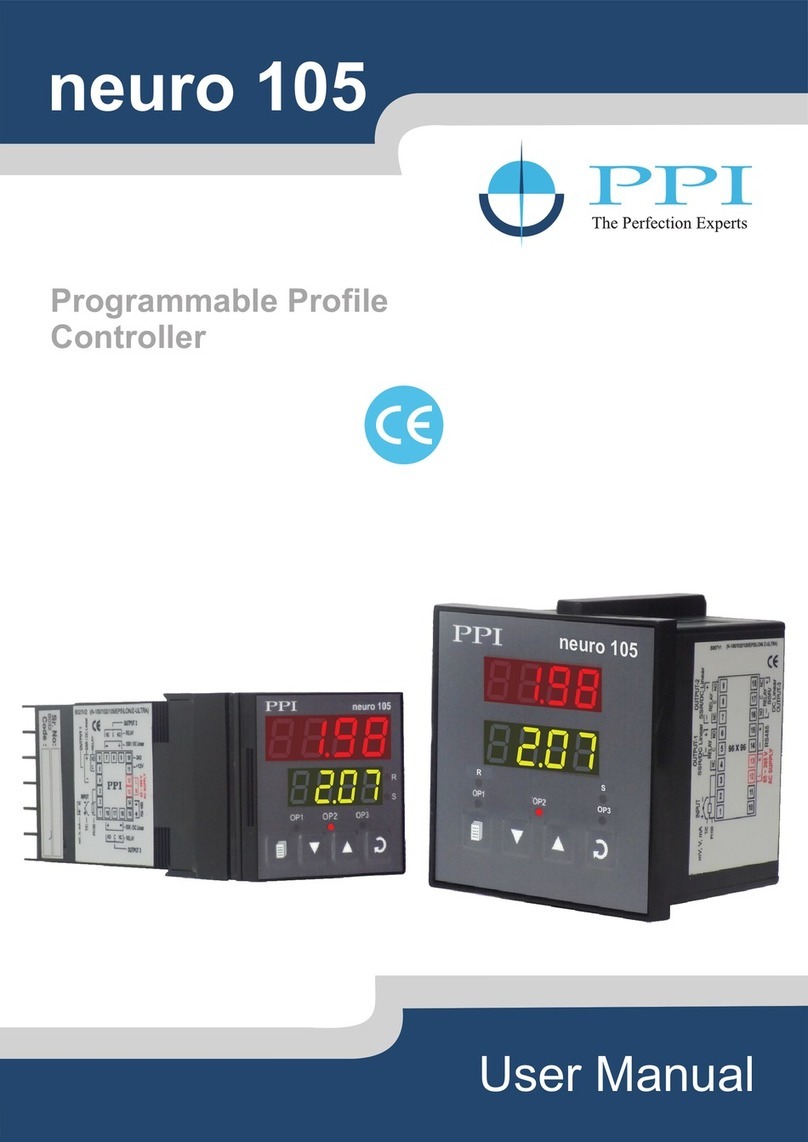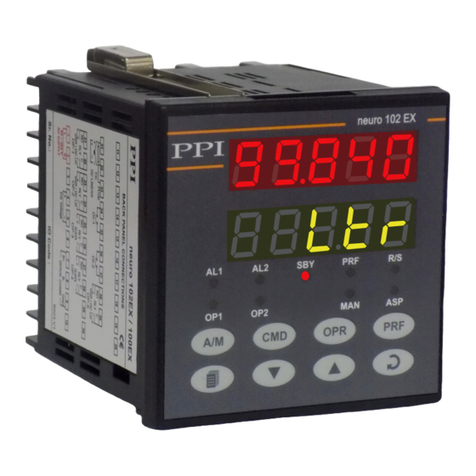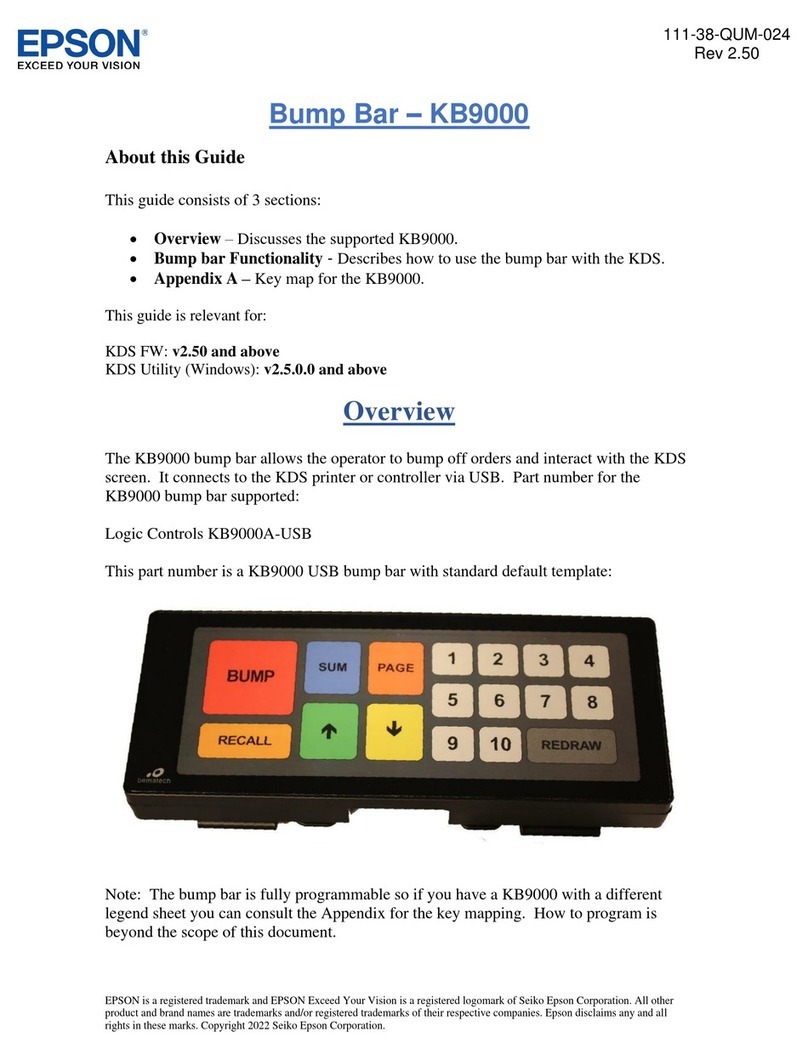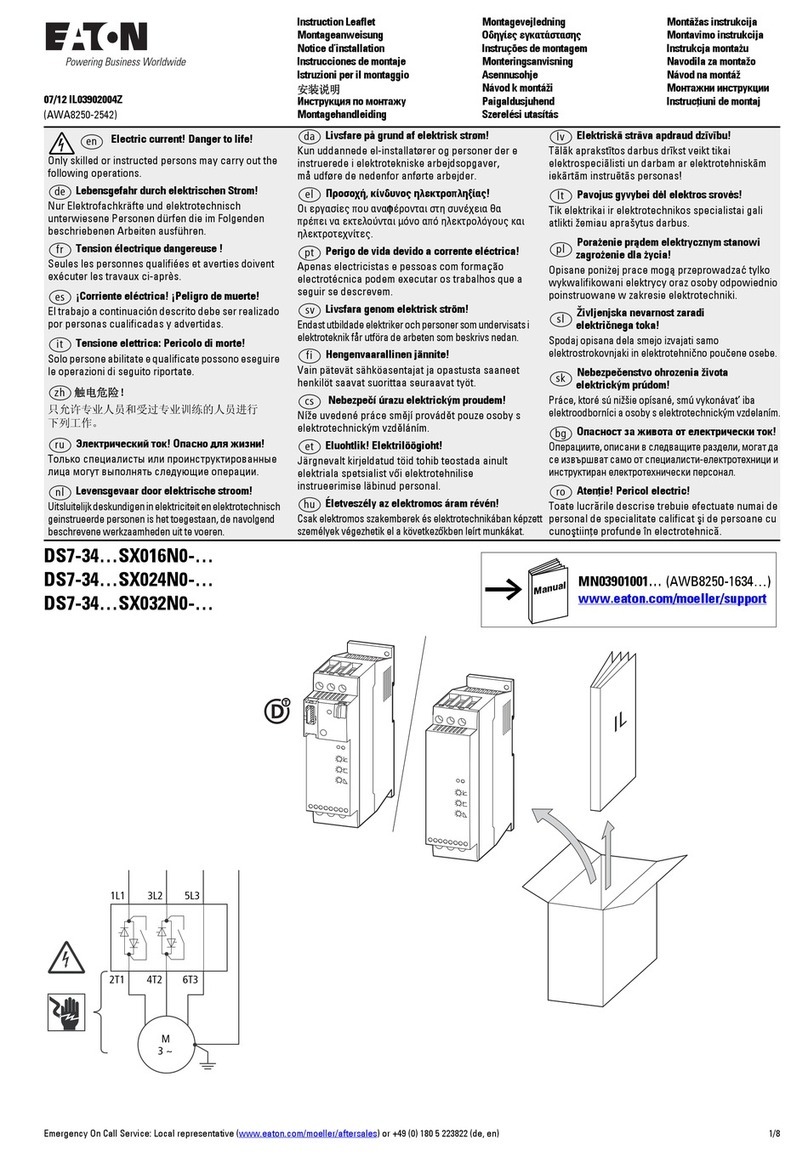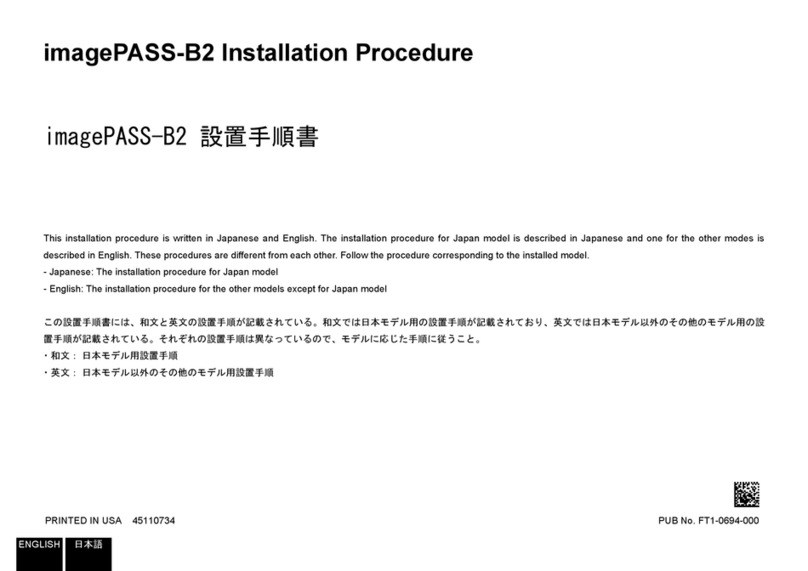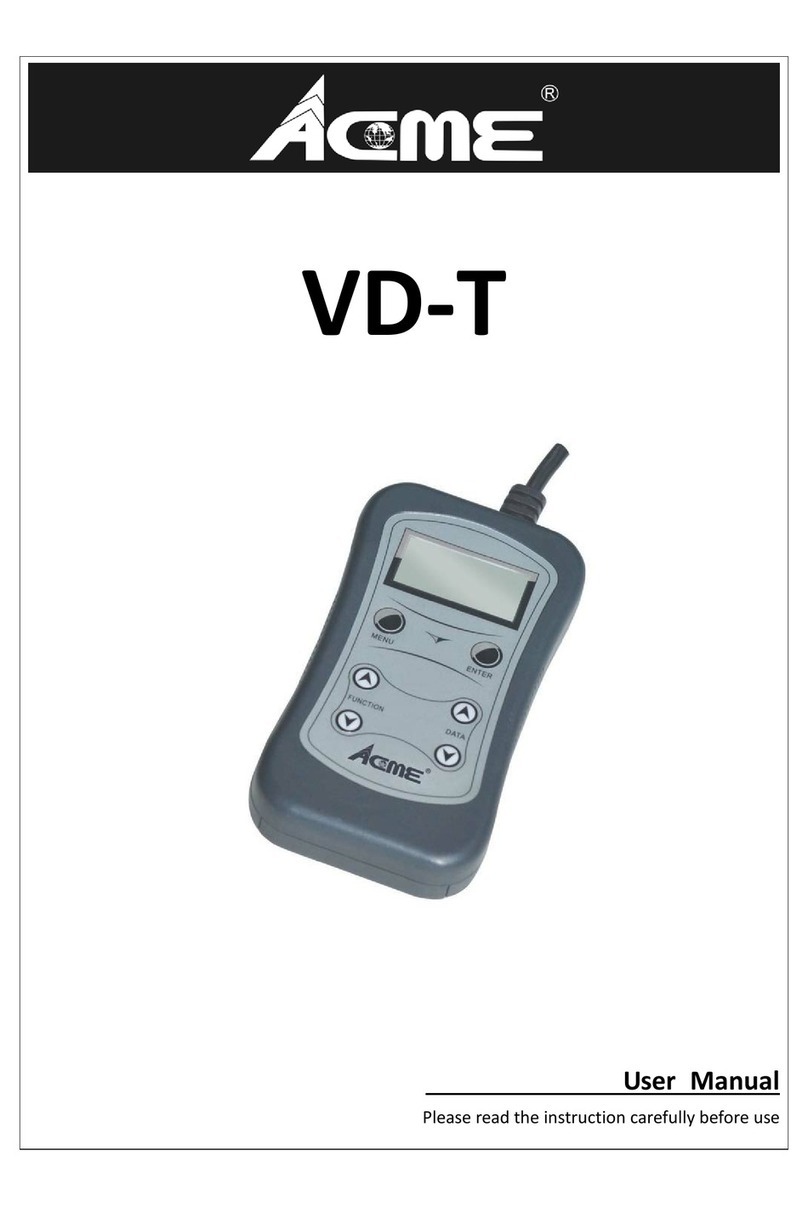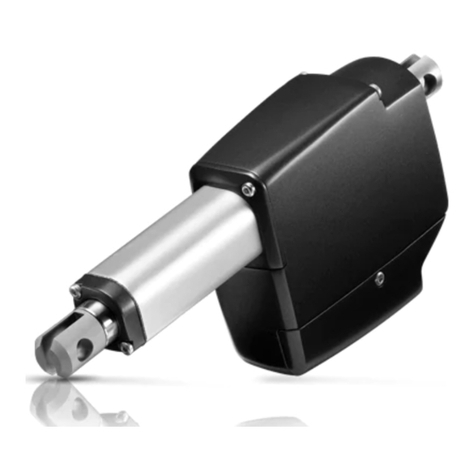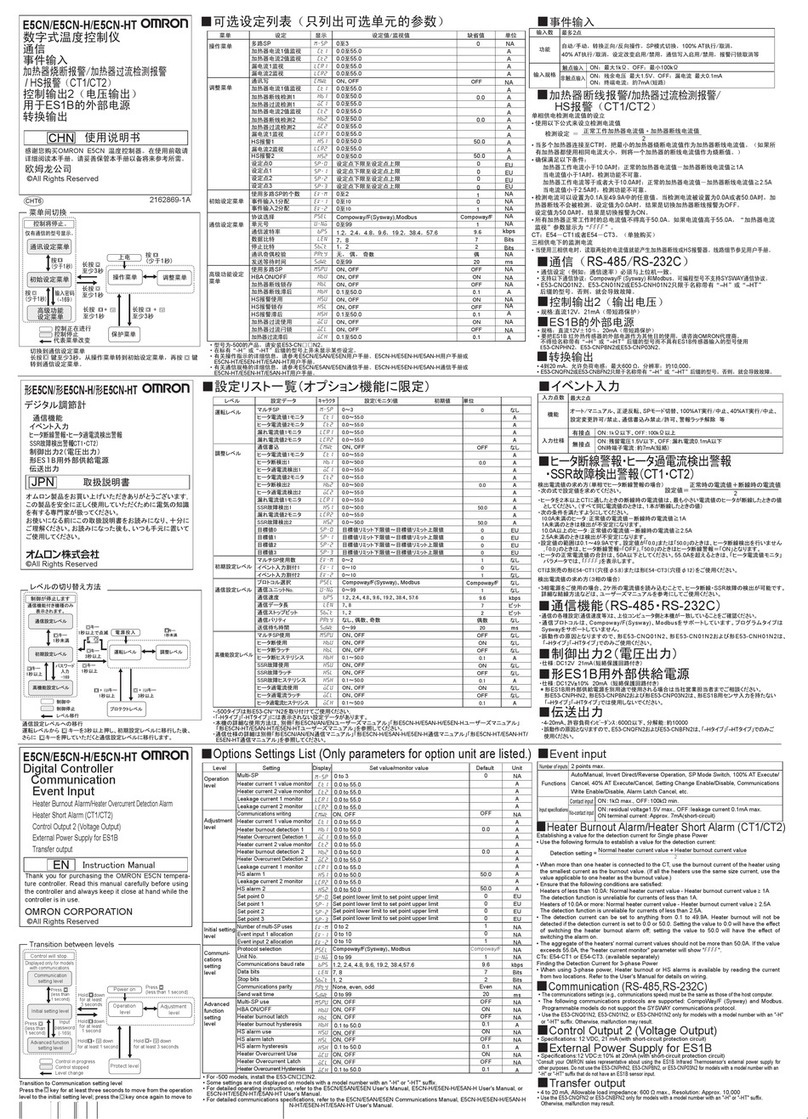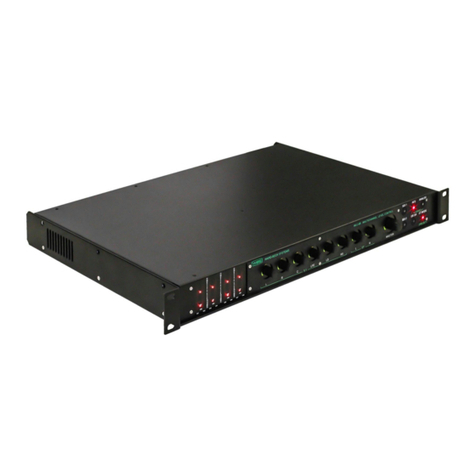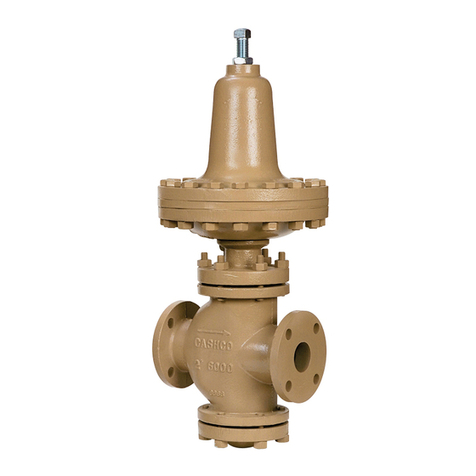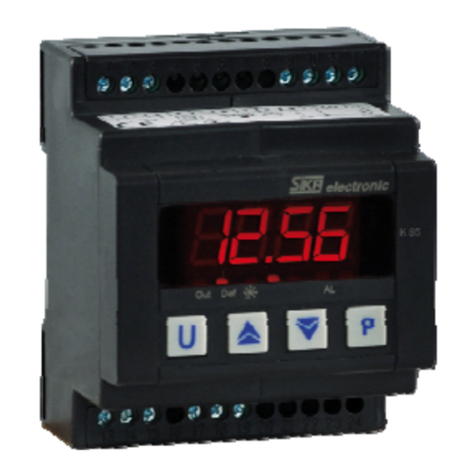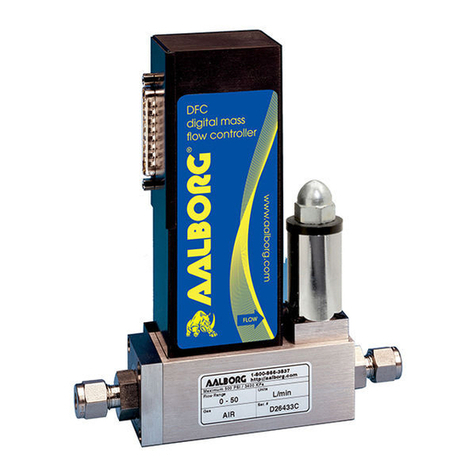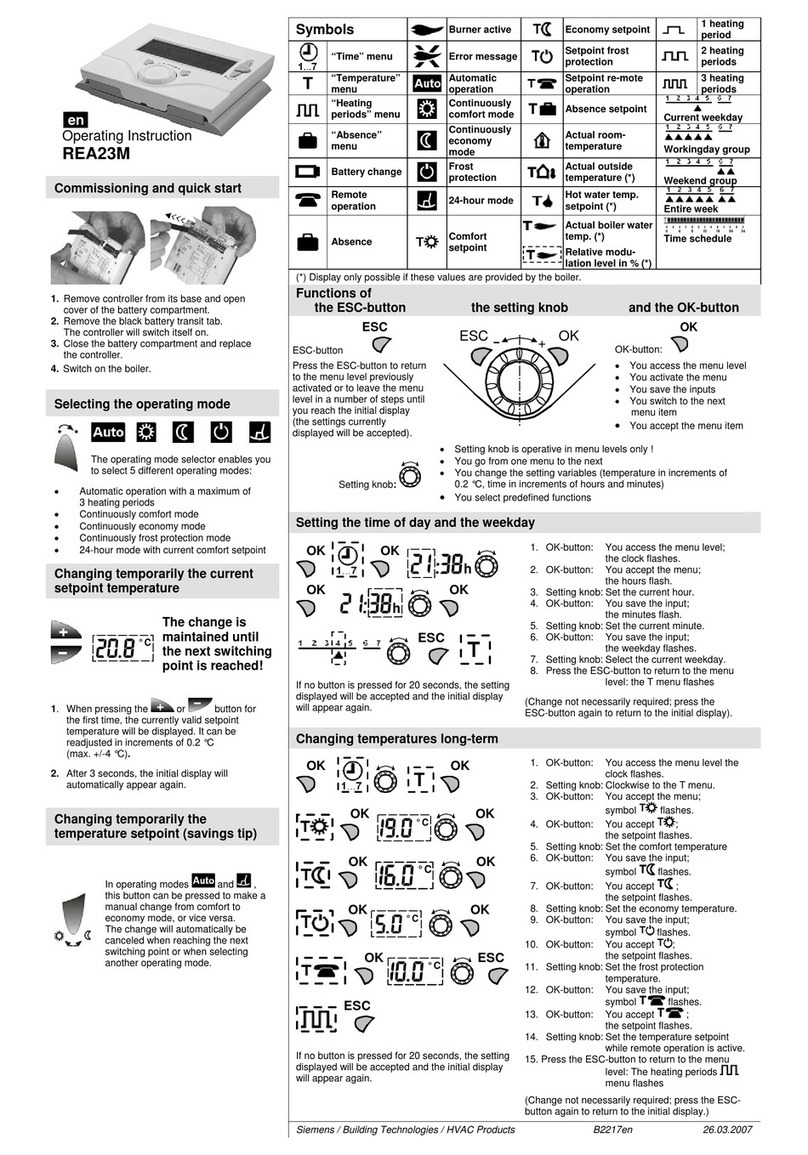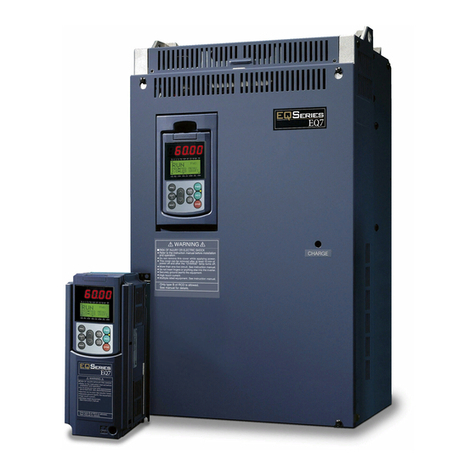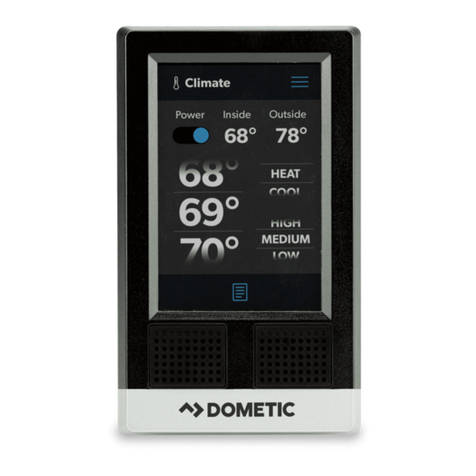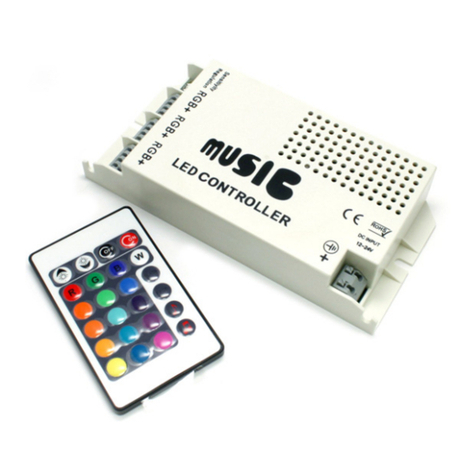PPI neuro 202 User manual

User Manual
neuro 202
neuro 202
User Manual
Enhanced
Universal Single Loop
Process Controller

User Manual
neuro 202
CONTENTS
1. FRONT PANEL LAYOUT 1
2. BASIC OPERATION 3
3. SET-UP MODE : ACCESS AND OPERATION 8
4. PAGE-10 : CONTROL PARAMETERS 10
5. PAGE-11 : ALARM RETRANSMISSION (RECORDER) PARAMETERS 12
6. PAGE-12 : INPUT/OUTPUT CONFIGURATION PARAMETERS 14
7. PAGE-13 : SUPERVISORY PARAMETERS 17
8. PAGE-16, PAGE-14, PAGE-1 : PROFILE PARAMETERS 19
9. PAGE-15 : OP1, OP2 & OP3 FUNCTION PARAMETERS 23
10. MECHANICAL INSTALLATION 26
11. ELECTRICAL CONNECTIONS 28
APPENDIX-A : DC LINEAR SIGNAL INTERFACE 32

1
User Manual
neuro 202
FRONT PANEL LAYOUT
Section 1
Figure 1.1
Table 1.1
The controller front panel comprises of digital readouts, LED indicators and membrane keys as shown in Figure 1.1 below.
READOUTS
The Upper Readout is a 4 digit, 7-segment bright green LED display and usually displays the PV (Process Value). In Set-up
Mode, the Upper Readout displays parameter values/options.
The Lower Readout is a 4 digit, 7-segment bright green LED display and usually displays Setpoint Value or % Output Power. In
Set-up Mode, the Lower Readout displays parameter names (prompts) .
INDICATORS
The front panel indicators are red LED’s that show the status related to control, alarm and operation mode. Refer Table 1.1
below for details.
AL1
AL2
MAN
OP1
neuro 202
PRF OP2
OP3COM
ACK
Upper Readout
Lower Readout
ENTER / Alarm ACK Key
UP Key
DOWN Key
PAGE Key
Serial Comm. Indicator
Alarm-1 Status Indicator
Alarm-2 Status Indicator
Profile Status Indicator
Auto/Manual Status Indicator
Output-1 Status Indicator
Output-2 Status Indicator
Output-3 Status Indicator
Status
Indicator
Flashes while Alarm-1 is active.
AL1
Flashes while Alarm-2 is active.
AL2
PRF
COM Serial Communication Status. Flashes when data is being exchanged with
Master Device.
• Flashes while the controller is executing ramp/soak profile cycle.
• Glows continuously if the profile cycle is in HOLD state.
• Remains OFF, if not executing a profile Cycle.
Indicates profile status if the Profile mode is Enabled.

2
User Manual
neuro 202
KEYS
There are four tactile keys provided on the front panel for configuring the controller, setting-up the parameter values and
selecting Operation Modes. Refer Table 1.2 for detailed key operations.
Table 1.2
Symbol Key Function
Press to enter or exit set-up mode.
PAGE
DOWN
UP
ENTER /
ACK
Set up Mode : Press to store the set parameter value and to scroll
to the next parameter on the PAGE.
Run Mode : Press to acknowledge any pending Alarm(s). This
also turns off the Alarm relay.
Press to increase the parameter value. Pressing once increases the
value by one count; keeping pressed speeds up the change.
Press to decrease the parameter value. Pressing once decreases
the value by one count; keeping pressed speeds up the change.
Status
Indicator
• Indicate Output-1, Output-2 & Output-3 ON/OFF status, respectively, if the
Output type is Relay or SSR.
• Remain OFF if the Output type is DC Linear.
OP1
OP2
OP3
MAN • Glows if the Manual (PID) mode is active.
• Remains OFF if Automatic (PID). Standby or Profile mode is active.

3
User Manual
neuro 202
Heat or Cool Power
Uni-directional Control Bi-directional Control
Heat Power Cool Power
Figure 2.1
Tune Mode Indication (PID Control)
The Lower Readout flashes (tUnE) while the controller is Tuning. Do not disturb the process or alter any parameter values
while Tuning is in progress. The “Tune” message automatically disappears upon completion of Tuning procedure.
Profile Mode Indications
(Applicable if controller is supplied with Ramp / Soak Profile option)
While a Profile Cycle is in progress, the front panel indicator ‘MODE’ flashes or glows steady with Green color. The steady
glowing indicates that though the profile is active, it is currently in HOLD state. Also, the Lower Readout shows the Profile
Setpoint instead of the control setpoint (SP). The % Output Power (if PID Control) can be viewed by toggling the Lower
Readout using ENTER key.
BASIC OPERATION
Adjusting SP (Control Setpoint)
If permitted at Supervisory Level, the SP value can be directly adjusted on the Lower Readout in the MAIN Display Mode.
While the Lower Readout shows the control setpoint, step through the following sequence for adjusting the SP value :
1. Press and release UP or DOWN key once. The Lower Readout starts flashing.
2. Use UP/ DOWN keys to adjust the SP value.
3. Press and release ENTER key. The Lower Readout stops flashing and the new set value is registered and stored.
Section 2
POWER-UP
Upon power-up the controller executes the following sequence of operations.
· Checks for Sensor Fault. If the connected sensor type is RTD Pt100 and the selected sensor type is any of thermocouples
or vice-a-versa; the controller displays sensor fault massage (S.FLt) on upper readout. The user is advised to take
necessary corrective action and press Enter key to acknowledge the fault.
· All displays and indicators are lit on for approximately 3 seconds to check any display segment failure.
· Displays controller model name on the Upper Readout and the firmware version on the Lower Readout, for approximately 1
second. This helps user to verify features and refer to the correct documents versions.
MAIN DISPLAY MODE
After the Power-up display sequence, the Upper Readout starts showing the measured PV (Process Value) and the Lower
Readout displays the Setpoint Value. This is the MAIN Display Mode that shall be used most often.
% Output Power Indication
In PID control mode, the Lower Readout can be toggled using ENTER key to indicate either % output power or setpoint value
SP. The output power is indicated with the left most digit showing ‘P’, ‘H’ or ‘C’ depending upon uni-directional (Heat or Cool) or
bi-directional (Heat and Cool) control mode. Refer Figure 2.1 below.

4
User Manual
neuro 202
Figure 2.3 (b)
Figure 2.3 (a)
Target
Ramp Set-point
Balance
Soak Time
Figure 2.2 (b)
Figure 2.2 (a)
Segment
Type
Ramp
Segment
Number
2
Segment
Type
Soak
Segment
Number
3
The Lower Readout also facilitates viewing the information about the current profile segment viz.; the Segment Number,
Segment Type (ramp / soak) and the Target Set-point (if current segment is ramp) or the Balance Time (if current segment is
soak).
Upon keeping the UP Key pressed, the Lower Readout shows the Segment Type and Segment Number as shown in Figure
2.2 (a) & 2.2 (b).
Upon keeping the DOWN Key pressed, the Lower Readout shows the Target Set-point (if current segment is ramp) or the
Balance Time (if current segment is soak) as shown in Figure 2.3 (a) & 2.3 (b).
Note :
If Profile Cycle is in progress; the controller is always in Auto Mode. That is, Manual Mode selection is suppressed.
Table 2.1
PV above Max. Range
PV below Min. Range
Upper Readout Error Type Cause
Thermocouple / RTD broken
Sensor Open
Under-range
Over-range
PV Error Indications
The PV Error ype is flashed on the Upper Readout. For different rror Types and the auses, refer Table 2.1 below.T E C
CONTROL / ALARM STATUS UNDER PV ERROR CONDITIONS
a) The tuning, if in progress, is aborted.
b) The Profile Cycle, if in progress, enters in HOLD state.
c) or error condition, all the control outputs are switched off. However, under While in Over-range Under-range Sensor Open
error, the PID control output power is maintained at the value set for the parameter “Sensor Break Output Power” on
PAGE-12.
d) For Alarm activation, the condition is treated as minimum PV, whereas the and Under-range Over-range Sensor Open
conditions are treated as maximum PV. Thus, Process High, positive Deviation Band and Window Band alarms activate
under error. Similarly, Process Low, negative Deviation Band and Window Band alarms activate Over-range/Sensor Open
during Under-range error.

5
User Manual
neuro 202
MANUAL MODE OPERATION
This operation mode is available only if the control action is PID and if the manual mode operation is permitted at supervisory
level. In this mode, the controller operates in Open Loop mode wherein the % Output Power is manually adjusted by the
operator. This mode is often used for process start-up to make sure that the process equilibrium is achieved before the control
is transferred for subsequent automatic (closed loop) control. The controller ensures a bumpless Auto / Manual transfer.
The manual mode can be activated or de-activated using ENTER key. While in manual mode, the Upper Readout shows PV
and the Lower Readout shows % Power that can be adjusted using UP/DOWN keys.
Follow the steps below to enter (Activate) into Manual Mode and to revert to (De-activate) Automatic Mode.
1. Hold ENTER key pressed for approximately 5 seconds until front panel indicator MAN glows steady.
2. Release Enter key. The controller is now placed in Manual mode. The Upper Readout displays the PV and the Lower
Readout displays the %Output Power.
3. Adjust the Output Power using the UP and DOWN keys. The Output Power is adjustable between the set Power Low and
Power High limits.
To de-activate the Manual mode; Hold the ENTER key pressed for approximately 5 seconds until the front panel indicator
MAN turns off. The controller now enters into Auto control mode with the first power same as that was adjusted last while in
Manual mode.
Notes:
1. The Controller can not be placed in Manual mode while a Profile Cycle is in progress. If the controller is in manual mode and if profile start
command is issued, the controller reverts to Auto Mode and initiates profile.
2. The Manual mode Activation / De-activation is suppressed while the Tuning is in progress. However, the Tuning procedure can be
activated regardless of whether the controller is in Auto or Manual control mode.
3. While the Controller is in Manual Mode, Standby Mode (explained later in this section) can not be entered and vice-a-versa.
4. If the power fails while the Manual Control Mode is active; upon resumption of power the controller continues to remain in Manual control
mode with the last user set power.
STANDBY MODE
This mode, allows the operator to put the controller in ‘indication-only’ mode wherein all the output control signals as well as
Alarm Relays are forced OFF. This may be desired prior to the start of a new process batch.
If enabled at supervisory level, the standby mode can be activated or de-activated by setting the parameter ‘Standby’ to Yes or
No, respectively. The standby parameter is available on Operator PAGE-0.
Notes:
1. The Standby mode and Tuning operation are mutually exclusive. If Standby mode is activated while the controller is tuning, the controller
aborts tuning operation and enters Standby mode.
2. If the Power Supply to the controller is switched-off or a Power-failure occurs while the controller is operating in Standby mode; upon
resumption of power, the controller continues to operate in Standby mode.
OPERATOR PAGE AND PARAMETERS
The controller provides a separate page that contains parameters that require frequent settings by the operator. The page is
called and the parameters are called . The availability of operator parameters is Operator Page Operator Parameters
controlled at supervisory level the parameter settings is not locked by the aster ock. and M L

6
User Manual
neuro 202
Accessing Operator Page & Adjusting Parameters
Step through the following sequence to open the operator page and to adjust the operator parameter values.
1. Press and release PAGE key. The Lower Readout shows (PAGE) and Upper Readout shows (0).
2. Press ENTER key. The Lower Readout shows prompt for the first available operator parameter and the Upper Readout
shows value for the parameter.
3. Use UP / DOWN keys to adjust the value and then press ENTER key to store the set value and scroll to next parameter.
The controller automatically reverts to MAIN Display Mode upon scrolling through the last operator parameter. Alternatively,
use PAGE key to return to MAIN Display Mode.
The operator parameters are described in Table 2.2. Note that the parameters presented on operator page depend upon the
functions selected/enabled and supervisory level permissions.
ACTIVATE / DE-ACTIVATE STANDBY MODE
Set the parameter value to ‘Yes’ or ‘No’ for entering and exiting the
Standby mode, respectively.
This is the Main Setpoint value that the controller respects for the
control purpose. This value is not applicable if running a profile or if
the controller is tuning or in standby mode.
CONTROL SETPOINT
Parameter Description Settings
ALARM-1 WINDOW BAND
The Alarm setpoint for Alarm-1 if the Alarm Type is the Window
Band value for Alarm-1.
ALARM-1 DEVIATION BAND
The Alarm setpoint for Alarm-1 if the Alarm Type is the Deviation
Band value for Alarm-1.
ALARM-1 SETPOINT
The Process High or Process Low limit for Alarm-1.
Table 2.2
Setpoint Low Limit
to Setpoint High Limit
(Default : -1999)
No
Yes
(Default : No)
Min. to Max. Range
specified for the
selected Input Type
(Default : Min or Max Range)
For DC mA/mV/V : 3 to 9999 counts
:For Thermocouples/RTD
3 to 999 or 0.3 to 999.9
(Default : )0
For DC mA/mV/V :
-1999 to 9999 counts
:For Thermocouples/RTD
-999 to 999 or -1.999 to 999.9
(Default : )0
The parameters in Operator Page are editable only if permission is enabled in Supervisory Page (PAGE-13)

7
User Manual
neuro 202
Parameter Description Settings
ALARM-2 WINDOW BAND
Same as that described for Alarm-1 above but applied to Alarm-2.
ALARM-2 DEVIATION BAND
ALARM-2 SETPOINT
Same as that for Alarm-1 above but
applied to Alarm-2.

8
User Manual
neuro 202
The various parameters are arranged in different groups, called PAGES, depending upon the functions they represent. Each
group is assigned a unique numeric value, called PAGE NUMBER, for its access.
The parameters are always presented in a fixed format: The Lower Readout displays the parameter prompt (Identification
Name) and the Upper Readout displays the set value. The parameters appear in the same sequence as listed in their
respective sections.
SET-UP MODE
The Set-up Mode allows the user to view and modify the parameter values. Follow the steps below for setting the parameter
values:
1. Press and release PAGE key. The Lower Readout shows PAGE and the Upper Readout shows page number 0. Refer
Figure 3.1.
2. Use UP / DOWN keys to set the desired PAGE NUMBER.
3. Press and release ENTER key. The Lower Readout shows the prompt for the first parameter listed in the set PAGE
NUMBER and the Upper Readout shows its current value. If the entered PAGE NUMBER is invalid (contains no
parameter list or any associated function), the controller reverts to the MAIN Display Mode.
4. Press and release the ENTER key until the prompt for the required parameter appears on the Lower Readout. (The last
parameter in the list rolls back to the first parameter).
5. Use UP / DOWN keys to adjust the parameter value. (The display flashes if UP key is pressed after reaching the maximum
value or DOWN key is pressed after reaching the minimum value).
6. Press and release the ENTER key. The new value gets stored in the controller’s non-volatile memory and the next
parameter in the list is displayed.
The Figure 3.1 illustrates the example of altering the value for the parameter ‘Control ’ from On-Off to PID. Action
SET-UP MODE : ACCESS AND OPERATION
Figure 3.1
Notes
1. Each page contains a fixed list of parameters that are presented in a pre-determined sequence. Note, however, that availability of a few
parameters, called Conditional Parameters, depend upon the settings for some other parameters. For example, the parameter ‘Control
Hysteresis’ for Output-1 is available only if, the set value for the parameter ‘Control Action’ is ‘On-Off’.
2. To exit the set-up mode and return to the MAIN Display Mode, press and release PAGE key.
3. If no key is pressed for approximately 30 seconds, the set-up mode times out and reverts to the MAIN Display Mode.
Section 3
Use UP/DOWN
keys to change
the value
Press ENTER
key to store the value &
move to next parameter
First Parameter
on Page-12
New Parameter
value
Next Parameter
on Page-12
or
or
Main Display
Mode
Default Page Page Number
Press PAGE
key to enter
Set-up Mode
Use UP/DOWN
key to set the
Page Number
Press ENTER
key to open
the Page

9
User Manual
neuro 202
MASTER LOCKING
The controller facilitates locking all the PAGES (except Operator PAGE) by applying Master Lock Code. Under Locking, the
parameters are available for view only and cannot be adjusted. The Master Lock, however, does not lock the operator
parameters. This feature allows protecting the rather less frequently used parameters against any inadvertent changes while
making the frequently used operator parameters still available for editing.
For enabling / disabling the Lock, step through the following sequence:
Locking
1. Press and release PAGE key while the controller is in the MAIN Display Mode. The Lower Readout shows PAGE and the
Upper Readout shows 0.
2. Use UP / DOWN keys to set the Page Number to 123 on the Upper Readout.
3. Press and release ENTER key. The controller returns to the MAIN Display Mode with the Lock enabled.
The Figure 3.2 below illustrates the Locking procedure.
Figure 3.2
Un-Locking
Repeat the Locking procedure twice for unlocking.
Press PAGE
key to enter Set-up mode
Use UP/DOWN keys
to set the ‘Locking’ Code
Press ENTER key to
Lock & Return to MAIN Mode
MAIN Mode
MAIN Mode
Default Page Locking Code
or

10
User Manual
neuro 202
Refer Table 4.1 for the parameter descriptions and settings.
PAGE-10 : CONTROL PARAMETERS
Table 4.1
0 to 600 Seconds
(Default : 16 sec.)
0 to 3600 Seconds
(Default : 100 sec.)
Parameter Description Settings
(Default Value)
PROPORTIONAL BAND
(Available for PID Control only)
Sets proportional gain (% power per unit error). Defined in same
units and resolution as that for PV.
INTEGRAL TIME
(Available for PID Control only)
Sets integral time constant in seconds. Setting the value to 0, cuts-
off integral action.
DERIVATIVE TIME
(Available for PID Control only)
Sets derivative time constant in seconds. Setting the value to 0,
cuts-off derivative action.
0.5 to 100.0 Seconds
(in steps of 0.5 secs.)
(Default : 10.0 sec.)
CYCLE TIME
(Available for PID Control only)
Sets the total ‘On + Off’ time in seconds for time modulating power
output through Output-1 Relay / SSR.
0.1 to 10.0
(Default : 1.0)
RELATIVE COOL GAIN
(Available for PID Control with bi-directional, that is, Heat-
Cool mode)
Sets the ratio of cooling power to the heating power.
COOL CYCLE TIME
(Available for PID Control with bi-directional, that is, Heat-
Cool mode)
Sets the On + Off cycle time in seconds for time modulating power
output through Output-2 Relay / SSR.
0.5 to 100.0 Seconds
(in steps of 0.5 secs.)
(Default : 10.0 sec.)
HYSTERESIS
(Available for On-Off or Pulsed On-Off Control only)
Sets differential (dead) band between On-Off switching for
Output-1. Defined in same units and resolution as that for PV.
PULSE TIME
(Available for Pulsed On-Off Control only)
Sets the total ‘On + Off’ pulse time in seconds for Output-1 Relay /
SSR output.
Pulse ON Time
to 120.0 Seconds
(Default : 2.0 sec.)
Section 4
1 to 9999 counts
(Default : 500)
1 to 9999 counts
(Default : 2)

11
User Manual
neuro 202
Parameter Description Settings
(Default Value)
COOL PULSE TIME
(Available for Pulsed On-Off Control with bi-directional
mode)
Sets the total ‘On + Off’ pulse time in seconds for Output-2 Relay /
SSR output.
Cool ON Time
to 120.0 Seconds
(Default : 2.0)
0.1 to Value set for
Cool Pulse Time
(Default : 1.0)
HEAT POWER LOW
(Available for PID Control only)
Sets the minimum % output power limit for Output-1.
0 to Heat Power High
(Default : 0)
HEAT POWER HIGH
(Available for PID Control only)
Sets the maximum % output power limit for Output-1 .
Heat Power Low to 100
(Default : 100)
COOL HYSTERESIS
(Available for On-Off or Pulsed On-Off Control with bi-
directional mode)
Sets differential (dead) band between On-Off switching for
Output-2. Defined in same units and resolution as that for PV.
COOL PULSE-ON TIME
(Available for Pulsed On-Off Control with bi-directional
mode)
Sets the ON pulse time in seconds for Output-2 Relay / SSR
output.
COOL POWER LOW
(Available for PID Control with bi-directional, that is, Heat-
Cool mode)
Sets the minimum % output power limit for Output-2.
0 to Cool Power High
(Default : 0)
0.1 to Value set
for Pulse Time
(Default : 1.0)
PULSE-ON TIME
(Available for Pulsed On-Off Control only)
Sets the ON pulse time in seconds for Output-1 Relay / SSR
output.
COOL POWER HIGH
(Available for PID Control with bi-directional, that is, Heat-
Cool mode)
Sets the maximum % output power limit for Output-2.
Cool Power Low to 100
(Default : 100)
1 to 9999 counts
(Default : 2)

12
User Manual
neuro 202
Refer Table 5.1 for parameter description & settings.
PAGE 11 : ALARM AND RETRANSMISSION (RECORDER) PARAMETERS
Table 5.1
Parameter Description Settings
(Default Value)
ALARM-1 TYPE
Selects the Alarm-1 activation type. Selecting ‘None’ disables the
alarm and suppresses all the related parameters for Alarm-1.
None
Process Low
Process High
Deviation Band
Window Band
(Default : None)
(Available for Process High or Process Low Alarm-1 Type)
Sets Alarm limit independent of control setpoint for Alarm-1
activation. Defined in same units and resolution as that for PV.
ALARM-1 SETPOINT
ALARM-1 DEVIATION BAND
(Available for Deviation Band Alarm-1 Type)
Sets positive or negative deviation (offset) limit from control
setpoint for High or Low Alarm-1 activation, respectively. Defined
in same units and resolution as that for PV.
Min. to Max. Range
specified for the
selected Input Type
(Default : Min or Max Range)
ALARM-1 WINDOW BAND
(Available for Window Band Alarm-1 Type)
Sets symmetrical positive and negative deviation (offset) limits
around control setpoint for both High and Low Alarm-1 activation.
Defined in same units and resolution as that for PV.
ALARM-1 HYSTERESIS
Sets differential (dead) band between Alarm-1 ON and OFF
switching states. Units and resolution are same as that for PV.
ALARM-1 INHIBIT
Setting to ‘Yes’ suppresses Alarm-1 activation upon power-up or
process start-up. (Default : No)
No
Yes
Section 5
For DC mA/mV/V : 1 to 9999 counts
For Thermocouples/RTD :
1 to 999 or 0.1 to 999.9
(Default : 2)
For DC mA/mV/V : 3 to 9999 counts
:For Thermocouples/RTD
3 to 999 or 0.3 to 999.9
(Default : 5)
For DC mA/mV/V :
-1999 to 9999 counts
For Thermocouples/RTD :
-999 to 999 or -1.999 to 999.9
(Default : 5)

13
User Manual
neuro 202
Parameter Description Settings
(Default Value)
Process Value
Setpoint
(Default : Process Value)
(Available if Output-3 function is recorder)
Selects either Process Value (PV) or Control Setpoint (SP) for
retransmission (recording).
PV/SP SELECTION FOR RETRANSMISSION
RECORDER (RETRANSMISSION) LOW
(Available if Output-3 function is recorder)
Sets the minimum value (PV or SP) that shall correspond to the
minimum recorder output signal level (0 mA or 4 mA or 0 V). (Default : -199)
Min. to Max. Range
Specified for the
Selected Input Type
(Default : 1376)
Min. to Max. Range
Specified for the
Selected Input Type
RECORDER (RETRANSMISSION) HIGH
(Available if Output-3 function is recorder)
Sets the maximum value (PV or SP) that shall correspond to the
maximum recorder output signal level (20 mA or 5 V or 10 V).
ALARM-2 TYPE
ALARM-2 SETPOINT
ALARM-2 DEVIATION BAND
ALARM-2 WINDOW BAND
ALARM-2 HYSTERESIS
ALARM-2 INHIBIT
Same as that described for Alarm-1 above but applied to Alarm-2.
Same as that for Alarm-1 above but
applied to Alarm-2.

14
User Manual
neuro 202
PAGE-12 : INPUT/OUTPUT CONFIGURATION PARAMETERS
Refer Table 6.1 for parameter description & settings.
Table 6.1
Parameter Description Settings
(Default Value)
CONTROL ACTION
Select appropriate Control Algorithm suited for process
requirement.
CONTROL LOGIC
Select Reverse (heat logic) or Direct (cool logic).
PV UNITS
(Available for Thermocouple / RTD Inputs)
Selects temperature measurement units in °C or °F.
INPUT TYPE
Select Input type in accordance with the type of Thermocouple or
RTD or Sensor / Transducer Output (mA/mV/V) connected for
process value measurement.
Refer Table 6.2
(Default : Type K)
(Default : C)°
°F
°C
(Default : Reverse)
Reverse
Direct
(Default : PID)
On-Off
PID
Pulse
Section 6
SETPOINT LOW LIMIT
Set minimum permissible value for control setpoint.
(Default : -199)
Min. Range to
Setpoint High for the
selected Input Type
SETPOINT HIGH LIMIT
Set maximum permissible value for control setpoint.
Setpoint Low to
Max. Range for the
selected Input Type
(Default : 1376)
0 to 100 %
(Default : 0 %)
Input Type Settings Default
0 to 20 mA 0.00 to Signal High 0.00
4 to 20 mA
0 to 80 mV
Reserved
0 to 1.25 V
0 to 5 V
0 to 10 V
1 to 5 V
4.00 to Signal High
0.0 to Signal High
0.00 to Signal High
0.000 to Signal High
0.000 to Signal High
0.00 to Signal High
1.000 to Signal High
4.00
0.0
0.00
0.000
0.000
0.00
1.000
SIGNAL LOW
(Available for DC linear mV/V/mA Inputs only)
The transmitter output signal value corresponding to PV RANGE
LOW parameter value. Refer Appendix-A : DC Linear Signal
Interface for details.
SENSOR BREAK OUTPUT POWER%
(Available for PID control only)
In case of Thermocouple / RTD broken or disconnected, the
controller outputs this power value under open loop condition.

15
User Manual
neuro 202
PV RESOLUTION
(Available for DC linear mV/V/mA & RTD Inputs only)
Set the process value indication resolution (decimal point). All the
resolution based parameters (Control Setpoint, Hysteresis, Alarm
Setpoints etc.) then follow this resolution setting.
PV RANGE LOW
(Available for DC Linear Inputs)
Set process value corresponding to SIGNAL LOW parameter
value. Refer Appendix-A : DC Linear Signal Interface for details.
PV RANGE HIGH
(Available for DC Linear Inputs)
Set process value corresponding to SIGNAL HIGH parameter
value. Refer Appendix-A : DC Linear Signal Interface for details.
Parameter Description Settings
(Default Value)
OFFSET FOR PV
This value is algebraically added to the measured PV to derive the
final PV that is displayed and compared for alarm / control.
Final PV = Measured PV + Offset
0.5 to 60.0 Seconds
(in steps of 0.5 Seconds)
(Default : 2.0 sec.)
DIGITAL FILTER TIME CONSTANT
Set the time constant, in seconds, for the low-pass digital filter
applied to the measured PV. The filter helps smoothing/averaging
the signal input and removing the undesired noise.
Input Type Settings Default
0 to 20 mA
4 to 20 mA
0 to 80 mV
Reserved
0 to 1.25 V
0 to 5 V
0 to 10 V
1 to 5 V
Signal Low to 20.00 20.00
20.00
80.00
80.00
1.250
5.000
10.00
5.000
Signal Low to 20.00
Signal Low to 80.00
Signal Low to 80.00
Signal Low to 1.250
Signal Low to 5.000
Signal Low to 10.00
Signal Low to 5.000
SIGNAL HIGH
(Available for DC linear mV/V/mA Inputs only)
The transmitter output signal value corresponding to PV RANGE
HIGH parameter value. Refer Appendix-A : DC Linear Signal
Interface for details.
Refer Table 6.2
(Default : 1)
-1999 to 9999
(Default : 0)
-1999 to 9999
(Default : 1000)
For DC mA/mV/V :
1 to 9999 counts
For Thermocouples/RTD :
1 to 999 or 0.1 to 999.9
(Default : 0)

16
User Manual
neuro 202
Table 6.2
Resolution
Option What it means Range (Min. to Max.)
Type J Thermocouple
Type K Thermocouple
Type T Thermocouple
0 to +960°C / +32 to +1760°F
-200 to +1376°C / -328 to +2508°F
-200 to +385°C / -328 to +725°F
Type R Thermocouple
0 to +1770°C / +32 to +3218°F
Fixed
1°C / 1°F
0 to 20mA DC current
4 to 20mA DC current
0 to 0mV DC voltage 8
Reserved
0 to 1.25V DC voltage
0 to 5.0V DC voltage
0 to 10.0V DC voltage
1 to 5.0V DC voltage
3-wire, RTD Pt100
-1999 to +9999 units
-199 to +600°C / -328 to +1112°F
-199.9 to 600.0°C / -199.9 to 999.9°F
or
User settable
1°C / 1°F
or
0.1°C / 0.1°F
User settable
1 / 0.1 / 0.01/
0.001 units
Type N Thermocouple
Type B Thermocouple
Type S Thermocouple
0 to +1300°C / +32 to +2372°F
0 to +1825°C / +32 to +3092°F
0 to +1765°C / +32 to +3209°F
Reserved for customer specific Thermocouple type not listed
above. The type shall be specified in accordance with the ordered
(optional on request) Thermocouple type.

17
User Manual
neuro 202
PAGE-13 : SUPERVISORY PARAMETERS
Refer Table 7.1 for parameter description & settings.
Table 7.1
Settings
(Default Value)
SELF-TUNE COMMAND
(Available for PID control only)
Set to ‘Yes’ to initiate a new tuning cycle or set to ‘No’ to abort a
tuning operation in progress.
Parameter Description
OVERSHOOT INHIBIT
(Available for PID control only)
Enabling this feature controls the rate of PV rise or fall upon
process start-up in order to reach the control setpoint with
minimum overshoot/undershoot possible.
1.0 to 2.0
(Default : 1.0)
OVERSHOOT INHIBIT FACTOR
(Available for PID control with Overshoot Inhibit enabled)
This parameter adjusts the effectiveness of the Overshoot Inhibit
feature. Increase the value if the overshoot is curbed but the PV
takes longer to reach the SP. Decreases the value if the overshoot
persists.
(Default : Disable)
Disable
Enable
(Default : No)
No
Yes
MANUAL MODE
Supervisory permission for Auto/Manual mode selection. Set to
‘Enable’ for permission.
SP ADJUSTMENT ON OPERATOR PAGE
Supervisory permission for control setpoint editing on Operator
Page. Set to ‘Enable’ for permission.
SP ADJUSTMENT ON LOWER READOUT
Supervisory permission for control setpoint editing on Lower
Readout. Set to ‘Enable’ for permission.
ALARM SP ADJUSTMENT
ON OPERATOR PAGE
Supervisory permission for Alarm setpoint adjustments on
Operator Page. Set to ‘Enable’ for permission.
STANDBY MODE
Supervisory control over availability of Standby (entry / exit)
command on Operator Page. ‘Enable’ for availability.
(Default : Enable)
Disable
Enable
(Default : Enable)
Disable
Enable
(Default : Disable)
Disable
Enable
(Default : Disable)
Disable
Enable
(Default : Disable)
Disable
Enable
Section 7

18
User Manual
neuro 202
Settings
(Default Value)
Parameter Description
PROFILE ABORT COMMAND
ON PAGE-1
Supervisory control over availability of Profile Abort command on
Page-1. ‘Enable’ for availability. (Default : Disable)
Disable
Enable
BAUD RATE
Communication speed in ‘Bits per Second’. Set the value to match
with the host baud rate.
COMMUNICATION PARITY
One of the communication error trapping features. Select the data
packet parity as implemented by the host protocol.
COMMUNICATION WRITE ENABLE
Setting to ‘No’ disallows the host to set or modify any parameter
value. The host, however, can read the values.
CONTROLLER ID NUMBER
Unique numeric code assigned to the controller for identification
by the host. Set the value as required by the host.
1 to 127
(Default : 1)
(Default : Yes)
No
Yes
(Default : Even)
None
Even
Odd
(Default : 9.6)
4800
9600
19200
Table of contents
Other PPI Controllers manuals
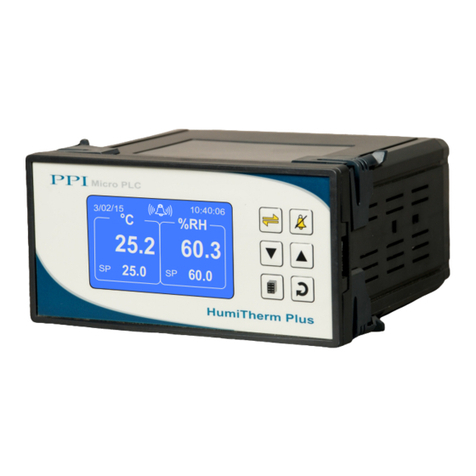
PPI
PPI HumiTherm Plus User manual
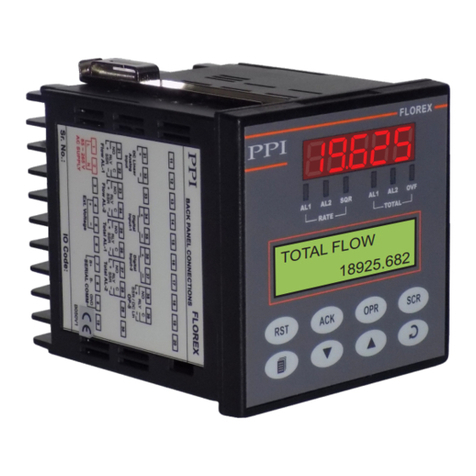
PPI
PPI FLOREX User manual
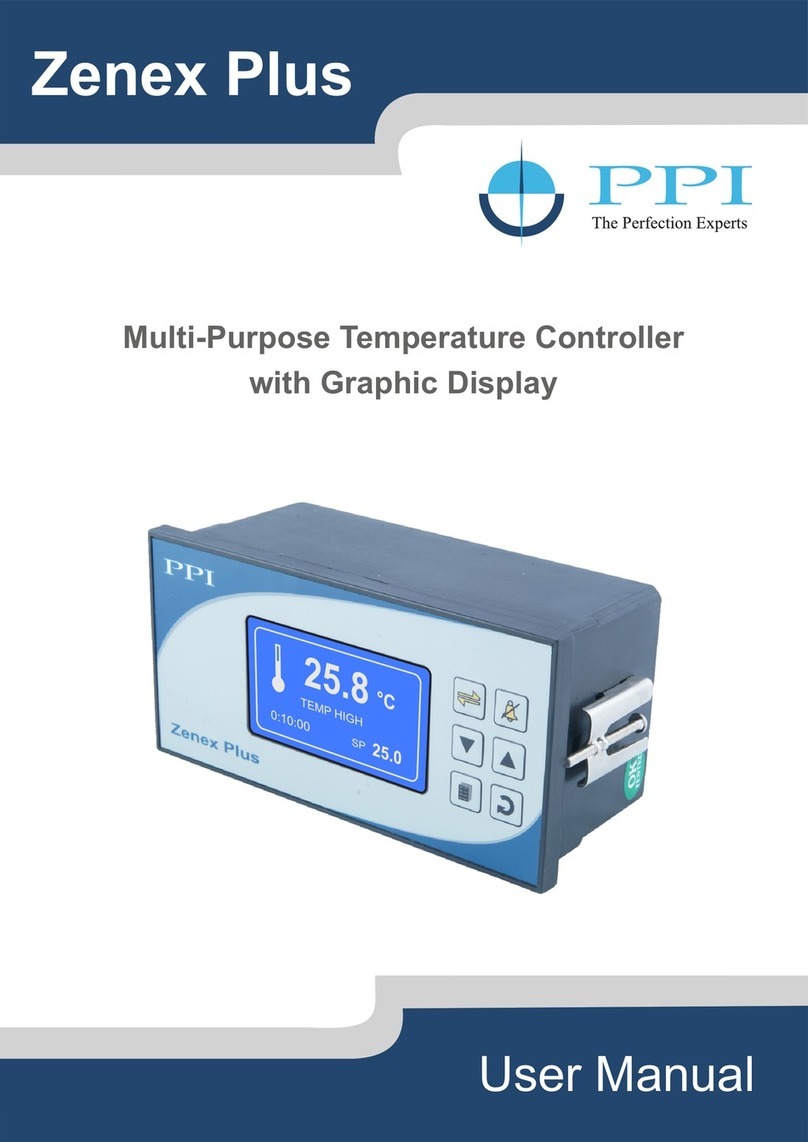
PPI
PPI Zenex Plus User manual
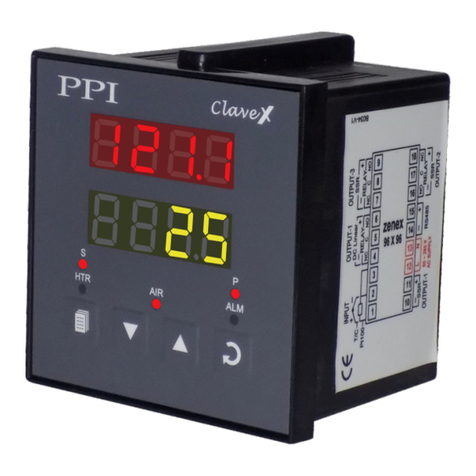
PPI
PPI claveX Series User manual

PPI
PPI neuro 102 EX User manual
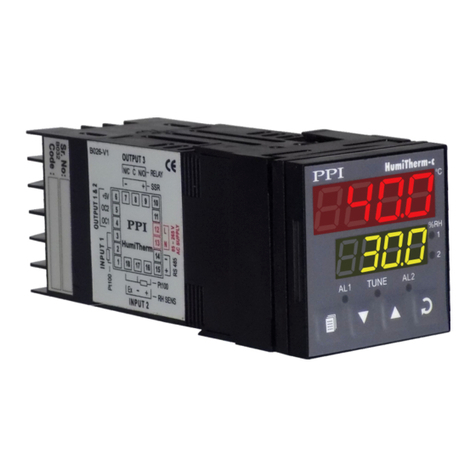
PPI
PPI HumiTherm-c Series User manual
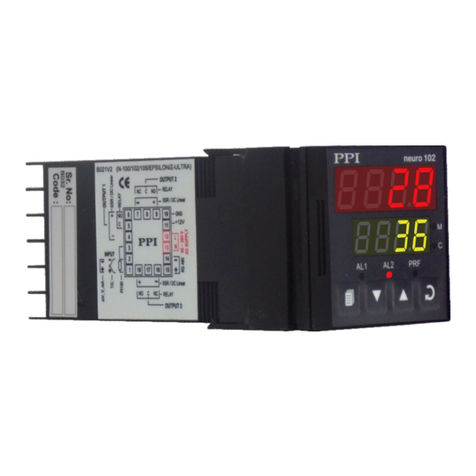
PPI
PPI neuro 102 User manual
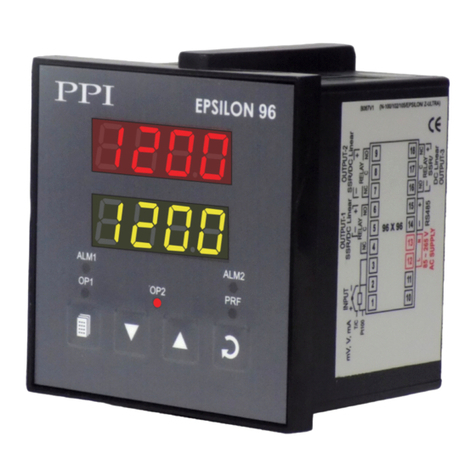
PPI
PPI Epsilon 48 User manual
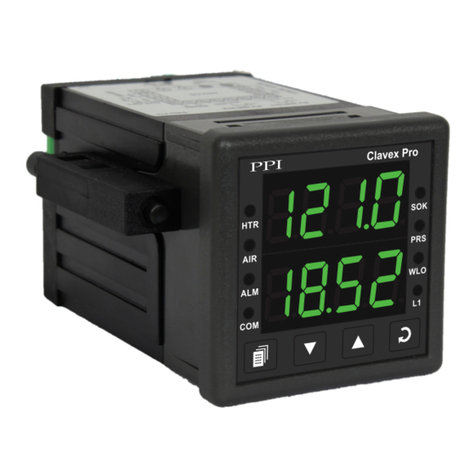
PPI
PPI Clavex Pro User manual

PPI
PPI neuro 105 User manual


